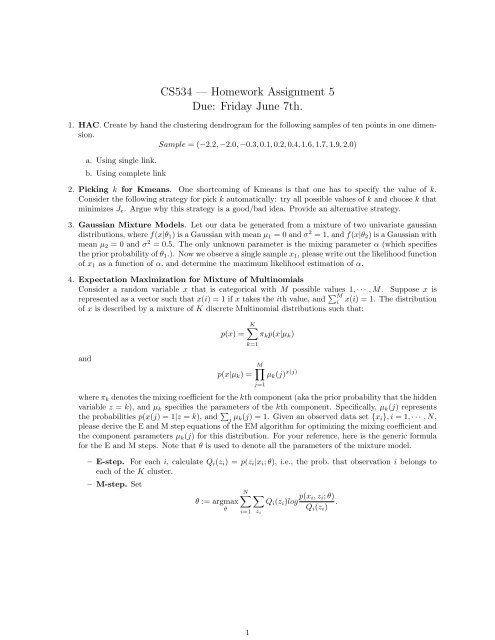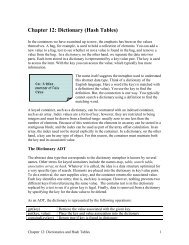CS534 â Homework Assignment 5 Due: Friday June 7th. - Classes
CS534 â Homework Assignment 5 Due: Friday June 7th. - Classes
CS534 â Homework Assignment 5 Due: Friday June 7th. - Classes
Create successful ePaper yourself
Turn your PDF publications into a flip-book with our unique Google optimized e-Paper software.
<strong>CS534</strong> — <strong>Homework</strong> <strong>Assignment</strong> 5<br />
<strong>Due</strong>: <strong>Friday</strong> <strong>June</strong> <strong>7th</strong>.<br />
1. HAC. Create by hand the clustering dendrogram for the following samples of ten points in one dimension.<br />
Sample = (−2.2, −2.0, −0.3, 0.1, 0.2, 0.4, 1.6, 1.7, 1.9, 2.0)<br />
a. Using single link.<br />
b. Using complete link<br />
2. Picking k for Kmeans. One shortcoming of Kmeans is that one has to specify the value of k.<br />
Consider the following strategy for pick k automatically: try all possible values of k and choose k that<br />
minimizes J e . Argue why this strategy is a good/bad idea. Provide an alternative strategy.<br />
3. Gaussian Mixture Models. Let our data be generated from a mixture of two univariate gaussian<br />
distributions, where f(x|θ 1 ) is a Gaussian with mean µ 1 = 0 and σ 2 = 1, and f(x|θ 2 ) is a Gaussian with<br />
mean µ 2 = 0 and σ 2 = 0.5. The only unknown parameter is the mixing parameter α (which specifies<br />
the prior probability of θ 1 .). Now we observe a single sample x 1 , please write out the likelihood function<br />
of x 1 as a function of α, and determine the maximum likelihood estimation of α.<br />
4. Expectation Maximization for Mixture of Multinomials<br />
Consider a random variable x that is categorical with M possible values 1, · · · , M. Suppose x is<br />
represented as a vector such that x(i) = 1 if x takes the ith value, and ∑ M<br />
i<br />
x(i) = 1. The distribution<br />
of x is described by a mixture of K discrete Multinomial distributions such that:<br />
and<br />
p(x) =<br />
p(x|µ k ) =<br />
K∑<br />
π k p(x|µ k )<br />
k=1<br />
M∏<br />
µ k (j) x(j)<br />
j=1<br />
where π k denotes the mixing coefficient for the kth component (aka the prior probability that the hidden<br />
variable z = k), and µ k specifies the parameters of the kth component. Specifically, µ k (j) represents<br />
the probabilities p(x(j) = 1|z = k), and ∑ j µ k(j) = 1. Given an observed data set {x i }, i = 1, · · · , N,<br />
please derive the E and M step equations of the EM algorithm for optimizing the mixing coefficient and<br />
the component parameters µ k (j) for this distribution. For your reference, here is the generic formula<br />
for the E and M steps. Note that θ is used to denote all the parameters of the mixture model.<br />
– E-step. For each i, calculate Q i (z i ) = p(z i |x i ; θ), i.e., the prob. that observation i belongs to<br />
each of the K cluster.<br />
– M-step. Set<br />
θ := argmax<br />
θ<br />
N∑ ∑<br />
Q i (z i )log p(x i, z i ; θ)<br />
.<br />
Q<br />
z i (z i )<br />
i<br />
i=1<br />
1
5. Dimension reduction.<br />
a. Consider the following data set, please draw on the picture the the 1st Principal component<br />
direction, and the direction for LDA respectively. Note for PCA, please ignore the markers, and<br />
for LDA, we treat the circles as one class and the rest as the other class.<br />
LDA<br />
PCA<br />
b. Given three data points, (0,0), (1,2), (-1, -2) in a 2-d space. What is the first principal component<br />
direction (please write down the actual vector)? If you use this vector to project the data points,<br />
what are their new coordinates in the new 1-d space? What is the variance of the projected data?<br />
2

















